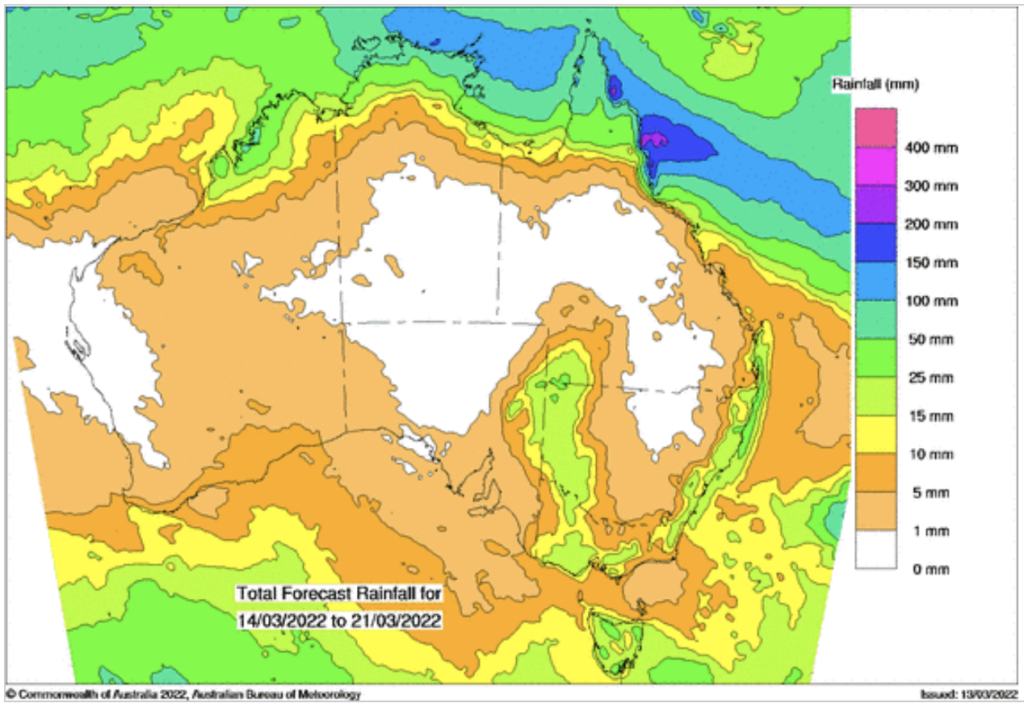Basis Commodities – Australian Crop Update – Week 11 2022
Market Update
It’s been an interesting week for Australian domestic markets. US futures fell by 10-15% before Friday’s modest bounce, but local cash markets were decidedly unmoved. Australian exporters that were short against nearby positions held bids, despite the decline in US futures and they were joined by domestic shorts who, until the invasion, were comfortable with limited cover on account of the record crop size.
Exporter bids for barley were higher across all port zones and this extended into the 2022/23 bids which emphasised what we have known for a while now – the disconnect between US futures and local cash markets. This disconnect has been evident for the past 18 months with the extreme weakness in basis and this may provide some longer-term opportunities as we move forward, although for now, caution is required.
It’s unlikely the Ukraine war will be resolved quickly. There may be a ceasefire, but removing sanctions takes a lot longer than putting them on and global buyers are now extremely sensitive to securing their supply chains given the reduced origination options.
For now, the market has covered what they can ahead of the northern hemisphere new crop inverse. The EU, we are told, is close to being sold out. Argentina is also down to fumes and although Indian exports will continue, it has its limitations from a phytosanitary and volume perspective. Australian export capacity is now largely booked through July and some in Southeast Asia have extended coverage into August/September and beyond.


Ocean Freight
Ocean freight remains firm, although we are starting to see some light on the horizon with fuel prices finally starting to drop. Whether this is a permanent fix or just a short-term blip is open to question and probably more influenced by OPEC than shipping. The ongoing imbalance between Atlantic and Pacific tonnage will continue at least in the short term. We are seeing vessels in Med being considered for Australian listings, such is the price disparity between the two. Although, the cost of the canal transit plus up-front bunker costs is a huge cashflow hit so it is not a major influence yet.
The paper markets for bunkers and freight are also stressing due to the potential for defaults on margin calls. The size of the margin calls and the risk of having Russian money somewhere/somehow in the chain has everyone questioning the very basis of their operations. Is that bunker hedge going to get paid even by a cleared exchange?
In this environment, anything other than spot or near-term business is very hard to execute.
Export Destinations
Australia exported 2.76MMT of wheat in January up from 2.18MMT in December as exports move into top gear. Exports are now running quickly in all states. Western Australia accounted for 899.5KMT followed by South Australia with 683KMT, New South Wales 548KMT, Victoria 449KMT and Queensland chipped in with 183KMT. Container wheat exports were strong at 264KMT. China was the largest destination with 687KMT. China has now taken 2.0MMT in the past three months. It’s being shipped from all states. Indonesia was the next largest behind China with 460KMT followed by the Philippines with 345KMT and then Vietnam with 222KMT. Yemen also took 187KMT.
Barley exports for January were 623KMT split between Western Australia, South Australia and Victoria. Saudi was the largest destination with 229KMT and has now taken just over 1MMT in the past four months. Jordan took another 126KMT. There is also a steady volume of shipments heading to the UAE, Qatar, Kuwait and Oman. Mexico took another 33KMT lifting the total shipments since September to 127KMT.
Canola exports for January were a whopping 763KMT. Most of this went to Europe apart from 70KMT to Japan, 111KMT to the UAE and 18KMT to Bangladesh.
Combined wheat, barley and canola exports for January were 4.15MMT.
Pulse exports were also very strong with Bangladesh the major destination.
The post Basis Commodities – Australian Crop Update – Week 11 2022 appeared first on Basis Commodities.
Share This Article
Other articles you may like
Sign Up
Enter your email address below to sign up to the Basis Commodities newsletter.






